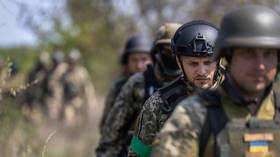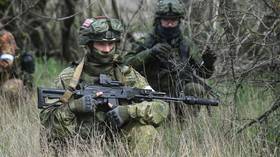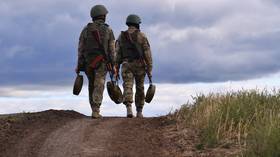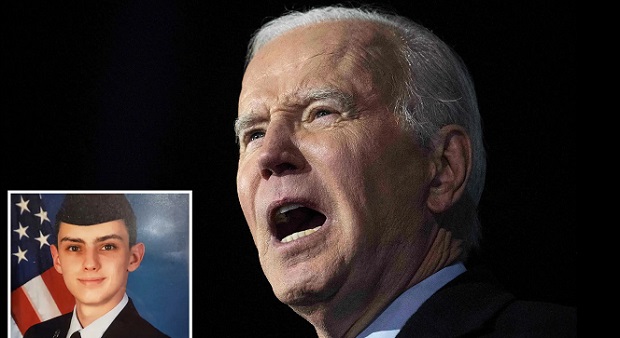‘FOOL’S ERRAND’ – YES, THE FOOL IS BIDEN & THE ERRAND IS UKRAINE – LEAKED PENTAGON DOCUMENTS A ‘COUP ATTEMPT’ BY THE ‘DEEP STATE’ IN WASHINGTON TO FORCE BIDEN’S OUSTER? – TO WARN AMERICANS ABOUT THE SHEER INCOMPETENCE & LIES OF HIS ADMINISTRATION & THE MOST DISHONEST-EVER MAINSTREAM MEDIA? – ‘YOU KNOW, IT’S A FOOL’S ERRAND IN UKRAINE. MAYBE, WE GOT TO GET OUT THE TRUTH. MAYBE, WE GOT TO EXPOSE PEOPLE FOR THE LIES THEY HAVE TOLD ABOUT UKRAINIAN PROGRESS & RUSSIANS BEING JUST PULVERISED. AND, MAYBE, THAT WILL STOP THIS WIDENING OF THE WAR’ – NO WONDER, ZELENSKY’S LONG-PROMISED ‘MAJOR COUNTEROFFENSIVE’ IS SO MYSTERIOUSLY DELAYED – WHILE FED-UP RUSSIANS MULL THE ‘COMPLETE DEFEAT & OVERTHROW OF THE KIEV REGIME… OR THE WAR WILL DRAG ON FOR A LONG TIME’
Why The Long-Awaited Ukrainian Counteroffensive Is Delayed
The much-touted and anticipated spring counteroffensive by the Ukrainian army is still on hold, and according to both Ukraine military and Western officials, it’s all due to mud. And yet, the White House has still offered an upbeat assessment of how Ukraine is fairing militarily. US National Security Council spokesman John Kirby only yesterday declared of Russia’s offensives against key holdout towns in Donetsk and Luhansk, “Most of these efforts have stalled and failed.” He asserted that “Russia has been unable to seize any real strategically significant territory.”
So Kirby paints a picture of a teetering Russian army, and still there’s no counteroffensive on the horizon. “But for the moment, they are barely moving forward, stalled not by ferocious Russian attacks, but by an enemy no less tenacious: the viscous central Ukrainian mud,” The New York Times wrote Monday. A Ukrainian officer interviewed by the Times acknowledged that “Until the weather improves, there will be no counteroffensive.” This is because: “the vehicles will get stuck and then what will we do if the shooting starts?”
The report further describes why Ukraine is holding off in saying, “Deep and black, with a consistency similar to a mixture of cookie dough and wet cement, the spring mud is one obstacle that the Ukrainian military, for all its ingenuity, finds difficult to overcome.” Further “It jams weapons and steals the boots from soldiers’ feet. Wheels and treads spin and spin, only digging military vehicles deeper into the mire.”

Echoing the same, Kiev’s ambassador to the UK, Vadim Pristayko, told Sky News on Tuesday, “Obviously, the weather is not allowing so far the heavy tanks to move in the Ukrainian usual spring mud.” Ukraine’s Defense Minister Aleksey Reznikov has also recently stated the weather has played a key role in determining the timing of a counteroffensive. Also, Russia has lately ramped up its strikes across the country. Is it really just mud and less than ideal weather stalling the counteroffensive? Or is there something more? –BY TYLER DURDENGeopolitical commentator Melkulangara Bhadrakumar explores the “something more” below via The Ron Paul Institute…
The month of May has arrived but without the long-awaited Ukrainian “counteroffensive”. The western media is speculating that it may come by late May. There is also the spin that Kiev is judicious to “buy time.” The chances of Ukraine making some sort of “breakthrough” in the 950-km long Russian frontline cannot be ruled out but a Russian counteroffensive is all but certain to follow. An open-ended war will not suit Western powers.
Last week, NATO’s top commander, US Army General Christopher Cavoli stated that the Russian army operating in Ukraine is larger than when the Kremlin launched its special military operation and the Ukrainians “have to be better than the Russian force they will face” and decide when and where they will strike.
Cavoli said Russia has strategic depth in manpower and has only lost one warship and about 80 fighters and tactical bombers in an air fleet numbering about 1,000 so far. The general gently contradicted Defence Secretary Lloyd Austin and Chief of General Staff Gen. Mark Milley who have been propagating that Russia is on the brink of defeat.
Speaking at the House panel on Wednesday, Gen. Cavoli said, “This war is far from over.” On Thursday, he went further to tell the Senate, “I think [the Russians] can fight another year.” At the House hearing, Cavoli also said Russian submarine activity has only picked up in the North Atlantic since the beginning of the war and none of the Kremlin’s strategic nuclear forces have been affected by operations in Ukraine.
He said at one point in his written testimony, “Russian air, maritime, space, cyber, and strategic forces have not suffered significant degradation in the current war. Moreover, Russia will likely rebuild its future Army into a sizeable and more capable land force… Russia retains a vast stockpile of deployed and non-deployed nuclear weapons, which present an existential threat to the US.”
Clearly, the entire narrative of lies and obfuscation created by the neocons in the Biden Administration through the past year has unraveled. The balance sheet shows there is nothing to justify the massive amount of aid to Ukraine through the past one-year period — in excess of $100 billion dollars, which is pro rata vastly more than what the US had spent in the twenty years of war in Afghanistan.
Gen. Cavoli’s testimony came soon after the leaked Pentagon documents recently, which has presented a grim picture of the state of Kiev’s military preparedness and the Biden Administration’s lack of confidence in the Zelensky regime.
The Pentagon documents echoed, in effect, a January study titled Avoiding a Long War by the RAND Corporation, which recommended that “the paramount US interest in minimizing escalation risks should increase the US interest in avoiding a long war (in Ukraine). In short, the consequences of a long war — ranging from persistent elevated risks to economic damage — far outweigh the possible benefits.”
Indeed, it appears that there is a significant stream of dissenting opinion within the US security and defence establishment, which estimates that President Biden has taken the US on a disastrous policy trajectory that is fated to have a calamitous outcome — a humiliating defeat in Ukraine that may damage the NATO alliance, weaken the transatlantic system and erode the US’ credibility as a global power.
Well-informed veterans of the US intelligence community regard the leaking of Pentagon documents itself as a mini-mutiny. The former CIA analyst Ray McGovern told China’s CGTN, “I believe it could be that some senior policymakers in the Pentagon at the highest reaches of the Department of Defense have decided, ‘You know, it’s a fool’s errand in Ukraine. Maybe, we got to get out the truth. Maybe, we got to expose people like Joint Chief of Staff Milley and Secretary Austin for the lies they have told about Ukrainian progress and Russians being just pulverised. And, maybe, that will stop this widening of the war.’ ”
The well-known former CIA analyst Larry Johnson shares the same view. He wrote: “This looks like a controlled, directed leak… the leaked material is not random intelligence material. It is designed to tell several stories. The most prominent is the deterioration of Ukrainian capabilities and the major obstacles confronting the United States and the rest of NATO in supplying badly needed air defence, artillery shells, artillery pieces and tanks. In other words, Ukraine is going to crash and burn.”
Johnson added, “Let me suggest one possibility for this leak — create a predicate for forcing Joe Biden from office. The revelations in the classified documents are not fabrications designed to deceive the Russians. Nor are they the kind of material to rally more US support for pouring more resources into the black hole of Ukraine. These leaks feed the meme that the Biden team is incompetent and endangering American interests overseas.”
Make no mistake, such coup attempts by the Deep State are nothing new in US presidential history — Eisenhower was undercut when he sought détente the Soviet Union; a whole corpus of materials available today suggests that CIA framed Nixon in the Watergate affair. Today, all this is happening against the backdrop of President Biden seeking a second term in the 2024 election.
As for Zelensky himself, he is acutely conscious that success or failure of his “counteroffensive” will be critical for continued western support. All things taken into account, a messy diplomatic scenario is looming ahead, one that would also open up divisions between western countries, and in which China could play a more important role.
There is no guarantee that public support for Biden’s proxy war would hold through the 2024 election. Suffice to say, it is increasingly doubtful whether Biden will sacrifice his presidency over the Ukraine war. These are of course early days. A large ship needs a big arc for turnaround.
The Russians are taking their decisions on the basis of own assessments. There has been a perceptible scaling up of Russian strikes against Ukrainian military facilities. Massive strikes deep into Ukrainian military’s rear areas have been reported.
An attack on Sunday on railroad infrastructure and depots for ammunition and fuel in Pavlograd, a major communication hub near Ukraine’s fourth-largest city of Dnepropetrovsk, was particularly devastating. The Ukrainian troops had been accumulating in Pavlograd for an offensive toward Zaporozhye. Two S-300 missile divisions were destroyed.
In the weekend, former president Dmitry Medvedev wrote in Telegram channel that Russia should seek “mass destruction” of Ukrainian personnel and military equipment”; deal a “maximum military defeat” on the Armed Forces of Ukraine; strive for “the complete defeat of the enemy and the final overthrow of the Nazi regime in Kiev with the complete demilitarization of the entire territory of the former Ukraine”; and press ahead with reprisals against key figures of the Zelensky government, regardless of their location, and without limits.”
Medvedev added, “Otherwise, they will not calm down… and the war will drag on for a long time. Our country doesn’t need that.” The mood has turned ugly and the conflict is set to take a vicious turn, as diplomacy has run aground completely. ZH
BREAKDOWN: Why Ukraine’s much-anticipated ‘counteroffensive’ could end in failure

Talk about a counteroffensive by the Armed Forces of Ukraine (AFU) has been doing the rounds for months, but it is still not clear when it might begin or whether it will happen at all. Previously, RT analyzed the readiness of the AFU for such an operation, but this time we will discuss the main challenges that may prevent Kiev’s troops from implementing or developing its political leaderships aims. And, perhaps most importantly, those of its Western sponsors.
What is the AFU’s main challenge in mounting this sort of endeavor?
We currently do not have any idea of where the AFU’s counteroffensive could take place, although Russian military bosses will be well aware of troop movements. If it involves an attempt to breakthrough the front line, then in addition to preparing reserves for battle, the AFU will need high-precision weapons.
Ukrainian troops will have to use long-range artillery rocket systems, including the US-supplied M142 HIMARS MLRS. Since the start of Moscow’s offensive, Kiev has used these systems only from deep within its own territory. However, to achieve momentum and penetrate the defense line, the systems will have to be moved closer to the front.

There is currently no doctrine or tested recommendations on using HIMARS/M270 MLRS in combined arms warfare or in such a large-scale war against a technologically advanced enemy.
Difficulties with logistics
Considering the risk of detection in areas with concentrated equipment, and Ukraine’s fear of losing reserves, as we see happening in Artemovsk (Bakhmut), the AFU will likely prepare its most important military formations from 12 to 36 hours before the main strike. In the present conditions, it is nearly impossible to amass enough fuel and ammunition. Not to mention the difficulties in trying to position people secretly. Russia has already used Lancet drones to hit German Gepard anti-aircraft guns and Soviet S-300 missile systems close to the front line. As soon as Ukraine’s previously hidden equipment was moved closer to the front line, it became easier to destroy.

With so many challenges, is it possible that the AFU could postpone the counteroffensive?
To successfully carry out a major counteroffensive, the AFU may not employ hi-tech equipment (like Bayraktar drones or M142 HIMARS systems) and instead rely on brute force: artillery, tanks, large numbers of infantry, and enormous amounts of cartridges, missiles, and shells. However, if something goes wrong, it will be difficult for Kiev to quickly replenish its ammunition. Ukraine’s troops are almost entirely dependent on foreign military aid, including critical weaponry like mortar shells, 122mm, 152mm, and 155mm artillery munitions, anti-tank systems, and cartridges for small arms. We can be certain that its General Staff understands this and the counteroffensive will take these restrictions into account. It’s also clear that the AFU lacks the power to break through a three to five line defensive front.
What conclusion can we reach?
Judging by the means at the disposal of the AFU, right now, Ukraine is likely to use the units formed with Western help in a rapid attempt to “puncture” the front.
Taking into account the current number of reserves, problems with logistics, and other challenges that will surely surface after the start of the counteroffensive, Kiev’s only realistic option is to launch an attack from a specific and previously unannounced direction.
Possible locations include Kherson, the Lugansk People’s Republic, or Zaporozhye. As a backup option, the AFU may consider attacking villages in the Kursk, Bryansk, and Belgorod regions, which are internationally recognised as part of Russia. However, the main challenge for Ukraine is that its first major strike – or even attempts to accumulate forces – may give the game away, and thus kibosh the whole plan. RT.COM
ZERO HEDGE / RT.COM
.
